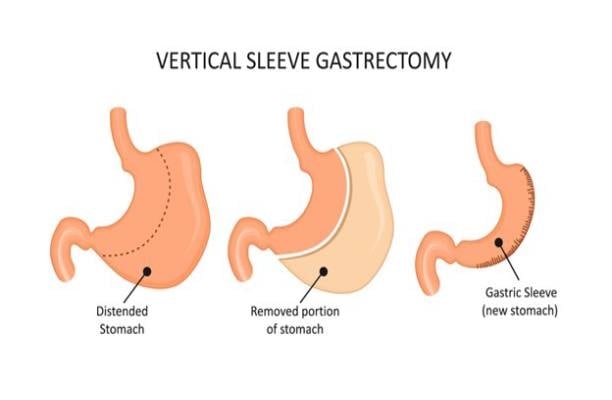Gastric Bypass versus Gastric Sleeve

- What is a gastric bypass?
- What is a gastric sleeve?
What is a gastric bypass?
It is a bariatric surgery that creates a small pouch from the stomach and connects the newly created pouch directly to the small intestine.
After gastric bypass, swallowed food will go into this small pouch of the stomach and then directly into the small intestine, thereby bypassing most of your stomach and the first section of your small intestine.

What is a gastric sleeve?
It is a bariatric surgery procedure where a large portion of the stomach is removed, leaving behind a narrow “Sleeve.”
Reducing your stomach helps restrict calories and reduce hunger signals.

Gastric Bypass vs. Gastric Sleeve Procedure: The similarities
|
Terms of similarity
|
Explanation
|
|
Reversibility
|
Not reversible
|
|
Stay in Hospital
|
2-3 days
|
Gastric Bypass vs. Gastric Sleeve Procedure: The differences
Below are the main differences :
|
Terms of Differences
|
Explanation
|
|
|
The procedure
|
Gastric Bypass
|
Creation of a small pouch connected to the small intestine
|
|
Gastric Sleeve
|
Removal of a portion of the stomach
|
|
|
Weight loss
|
Gastric Bypass
|
More
|
|
Gastric Sleeve
|
Less
|
|
|
Time required for weight loss
|
Gastric Bypass
|
Faster
|
|
Gastric Sleeve
|
Slower
|
|
|
Risk
|
Gastric Bypass
|
Higher
|
|
Gastric Sleeve
|
Lower
|
|
|
Recovery
|
Gastric Bypass
|
Slower
|
|
Gastric Sleeve
|
Faster
|
|
Gastric Bypass vs. Gastric Sleeve: The ideal candidates
For the majority of surgeries, you need to meet the following requirements:
- Have a BMI of 40 or greater.
- Have a BMI of 35 or greater with comorbidity.
- Be healthy enough to undergo surgery.
- I have made earnest efforts to lose weight through diet and exercise.
- Been overweight for more than just a couple of years.
The differences in terms of advantages and disadvantages
Advantages:
- One of the biggest advantages of gastric sleeve and gastric bypass surgery is that they significantly reduce your risk of obesity-related conditions, such as:
- Type 2 diabetes
- Hypertension, or high blood pressure
- Hyperlipidemia, or high levels of cholesterol and triglycerides
- Heart disease
- Stroke
- Fatty liver disease
- Sleep apnea
- Knee or hip pain
- Improve Physical function, mood, and quality of life.
Disadvantages:
- Not reversible.
- Weight loss may be difficult or lessened in certain conditions
- The body still tolerates carb-rich and high-fat foods, which can slow weight loss
- No dumping syndrome (discomfort from eating foods rich in carbs)
- Potential for leaks and other complications exists
The differences in terms of results
Gastric bypass results in more weight loss in a shorter time, as of 12 to 18 months after the surgery you might lose up to 80% of your weight in gastric bypass while you lose up to 70% in gastric sleeve.
How can ILAJAK help in choosing the most appropriate weight loss procedure?
ILAJAK Medical FREE consultation with experienced medical consultants, they will explain all the available procedures with their advantages and disadvantages, and with the help of our surgeons, we recommend the best procedure for you as per your condition and your expectations.
Gastric Bypass versus Gastric Sleeve faqs
ILAJAK Medical | A Passion for Care




tags
Treatment Services
In the Best Medical Centers
Contact Us
Please fill the form below and describe your condition, We will contact you back
- Dental Treatment
- Hair Transplant
- Obesity Surgery
- Vision Correction
- Health Resorts
- Other Medical Services
- No elements found. Consider changing the search query.
- List is empty.
Your personal data is processed as indicated in the general statement text and by continuing, you explicitly consent to the processing

